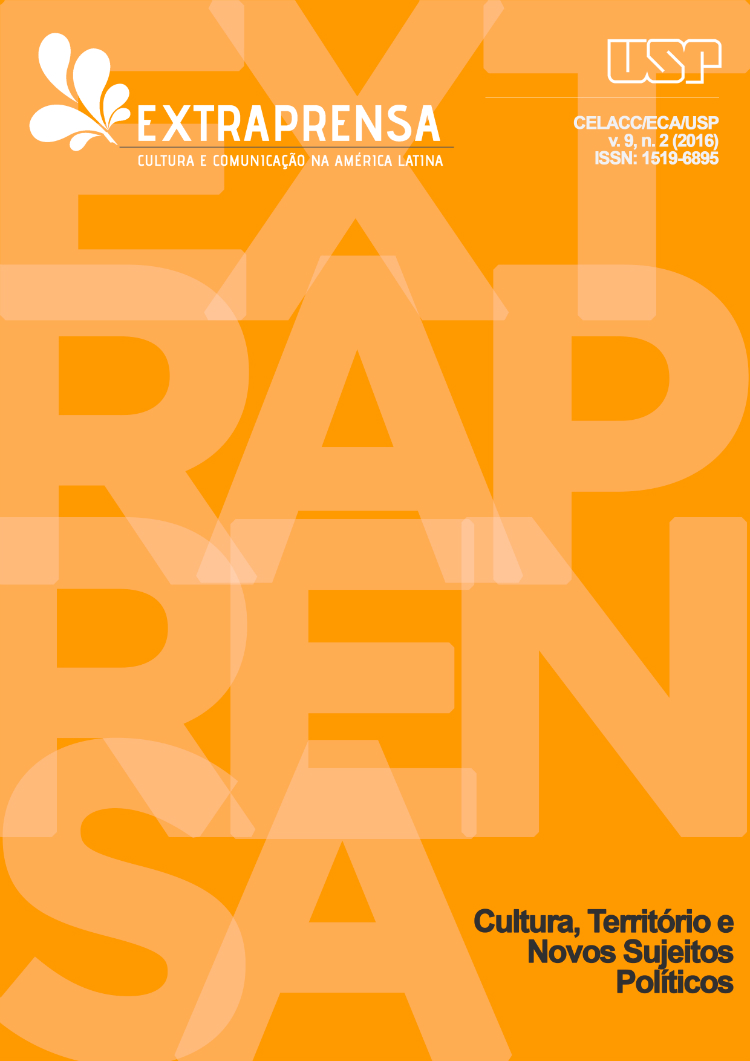Críticas a la teoría de la esfera pública de Jürguen Habermas
DOI:
https://doi.org/10.11606/extraprensa2016.116806Keywords:
Deliberation, public sphere, Habermas, Democracy, CommunicationAbstract
The present article examines the relationship between political philosophy and theory of communication in Habermas`s paradigm of public sphere. It focuses o the connection between public and individual reason, public spheres and state and, finally, between discursive practices and the structure of modern communication. The most important objective of the article is to explore what are the conditions in which political subjects take part in the public arena. Without pretensions to compile all possible critics to Habermas`s theory, this article relates opinions of prominent authors like Chantal Mouffe, John B. Thompson, Jacques Rancière, among others.
Downloads
References
Arias Maldonado, M. (2007). La política en la teoría deliberativa. Notas sobre deliberación, decisión y conflicto. Revista Española de Ciencia Política, Vol. 16, 37-59.
Bourdieu, P. (2004). Intervenciones 1961-2001. Ciencia social y acción política. Marsella: Editoriales Hiru y Ciencias Sociales.
Calhoun, C. (1992). Introduction: Habermas and thepublicsphere. En Habermas and thepublicsphere. Cambridge, Massachusetts y Londres, ReinoUnido: Massachussetts Institute of Technology Press.
Castells, M. (2008). The new public sphere: global civil society, communication networks and global governance. The ANNALS of the American Academy of Political and Social Science, 616, 78-93.
Dahlgren, P. (2005). The Internet, public spheres, and political communication: dispersion and deliberation. Political Communication, No. 22, 147-162.
Elster, J. (1991). The possibility of rational politics [VersiónElectrónica].Political Theory Today, Oxford.
Fraser, N. (1990). Rethinking the public sphere: A contribution to the critique of actually existing democracy [VersiónElectrónica].Social Text, No. 25/26, 56-80.
Giddens, A. (1997). Globalization: Keynote address at the UNRISD conference on globalization and citizenship [VersiónElectrónica]. URISD News, No. 15.
Grice, H. P. (1975). Logic and Conversation, Sintax and Semantic.ReinoUnido: C. England & H. Morgan, Editors.
Gutmann, A., & Thompson, D. (1990).Moral conflict and political consensus.Ethics, Vol. 101, 64-88.
Habermas, J. (1974). The public sphere: an encyclopaedia article. New German Critique, 1(2), 44-55.
Habermas, J. (1987). Teoría de la acción comunicativa. Madrid: Editorial Taurus.
Habermas, J. (1992). Further reflections on the public sphere (T. Burger, Trad.).En C. Calhoun (Ed.), Habermas and the public sphere. Cambridge, Massachusetts y Londres, ReinoUnido: Massachussetts Institute of Technology Press.
Habermas, J. (1997). Historia y crítica de la opinión pública. Barcelona: Ediciones G.
Habermas, J. (2005). Facticidad y validez (M. J. Redondo, Trad. 4ta ed.). Madrid: Editorial Trotta.
Keane, J. (1997). Transformaciones estructurales de la esfera pública. SociologicalStudies, XV(43), 47-77.
Lotman, I. M. (1996). Acerca de la semiosfera (D. Navarro, Trad.). En D. Navarro (Ed.), La semiosfera I (pp. 11-27). Madrid: Ediciones Cátedra.
Lotman, I. M. (1998a). Cerebro-texto-cultura-inteligencia artificial (D. Navarro, Trad.). En D. Navarro (Ed.), La semiosfera II (pp. 5-15). Madrid: Ediciones Cátedra.
Lotman, I. M. (1998b). El fenómeno de la cultura (D. Navarro, Trad.). En D. Navarro (Ed.), La semiosfera II (pp. 5-15). Madrid: Ediciones Cátedra.
Lotman, I. M. (1998c). Sobre los dos modelos de la comunicación en el sistema de la cultura (D. Navarro, Trad.). En D. Navarro (Ed.), La semiosfera II (pp. 27-43). Madrid: Ediciones Cátedra.
Mouffe, Ch. (1993). El retorno de lo político. Barcelona: Editorial Paidós.
Mouffe, Ch. (2002). For an agonistic public sphere.En G. Fieuek (Ed.), Democracy Unrialized (pp. 87-97). New York: Art Publisher, Inc.
Noelle-Neuman, E. (1995). La espiraldelsilencio. Barcelona: Editorial Paidós.
Peters, B. (2011). El sentido de la esfera pública. Criterios, Vol. 37, 5-54.
Rancière, J. (1995). En los bordes de lo político [Versión Electrónica].
Rancière, J. (2010). The aesthetics revolution and its outcomes (S. Corcoran, Trads.).En S. Corcoran (Ed.), Dissensus. On Politics and Aesthetics (pp. 115-135): Continuum Publishers.
Searle, J. R. (1986). Actos de habla. Madrid: Ediciones Cátedra.
Shapiro, I. (1999). Enough of deliberation: Politic is about interests and power. En S. Macedo (Ed.), Deliberative politics. Essays on democracy and disagreement, (pp. 28-38). Oxford: Oxford University Press.Smith, B. (2003). John Searle. Cambridge: Cambridge University Press.
Thompson, J. B. (1998). Los media y la modernidad. Barcelona: Editorial Paidós.
Downloads
Published
Issue
Section
License
Ao submeter qualquer material científico para Extraprensa, o autor, doravante criador, aceita licenciar seu trabalho dentro das atribuições do Creative Commons, na qual seu trabalho pode ser acessado e citado por outro autor em um eventual trabalho, porém obriga a manutenção de todos os autores que compõem a obra integral, inclusive aqueles que serviram de base para o primeiro.
Toda obra aqui publicada encontra-se titulada sob as seguintes categorias da Licença Creative Commons (by/nc/nd):
- Atribuição (de todos os autores que compõem a obra);
- Uso não comercial em quaisquer hipóteses;
- Proibição de obras derivadas (o trabalho não poderá ser reescrito por terceiros. Apenas textos originais são considerados);
- Distribuição, exibição e cópia ilimitada por qualquer meio, desde que nenhum custo financeiro seja repassado.
Em nenhuma ocasião a licença de Extraprensa poderá ser revertida para outro padrão, exceto uma nova atualização do sistema Creative Commons (a partir da versão 3.0). Em caso de não concordar com esta política de Direito Autoral, o autor não poderá publicar neste espaço o seu trabalho, sob pena de o mesmo ser removido do conteúdo de Extraprensa.







